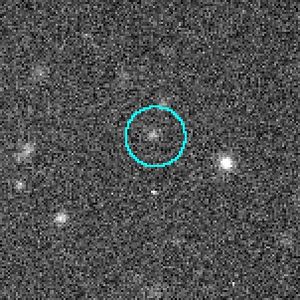Stephano (moon) facts for kids
| Discovery | |||||||
|---|---|---|---|---|---|---|---|
| Discovered by | Brett J. Gladman, Matthew J. Holman, John J. Kavelaars, Jean-Marc Petit, and Hans Scholl |
||||||
| Discovered in | July 18, 1999 | ||||||
| Orbital characteristics | |||||||
| Mean radius | 8,004,000 km | ||||||
| Eccentricity | 0.2295 | ||||||
| Orbital period | 677.37 d | ||||||
| Inclination | 141.81° (to the ecliptic)144°) | ||||||
| Is a moon of | Uranus | ||||||
| Physical characteristics | |||||||
| Mean diameter | ~32 km (estimate) | ||||||
| Surface area | ~3000 km² (estimate) | ||||||
| Volume | ~20,000 km3 (estimate) | ||||||
| Mass | ~6.0×1015 kg (estimate) | ||||||
| Mean density | ~1.5 g/cm3 (estimate) | ||||||
| Surface gravity | ~0.0041 m/s2 (estimate) | ||||||
| Escape velocity | ~0.0090 km/s (estimate) | ||||||
| Rotation period | ? | ||||||
| Axial tilt | ?° | ||||||
| Albedo | 0.04 (assumed) | ||||||
| Surface temp. |
|
||||||
| Atmospheric pressure | 0 kPa | ||||||
Stephano is one of the many moons that orbit the planet Uranus. It is a small, oddly shaped moon that moves in a "retrograde" orbit. This means it orbits Uranus in the opposite direction compared to most other moons.
Scientists discovered Stephano in 1999. It was found by a team of astronomers including Brett J. Gladman. When it was first found, it was given a temporary name: S/1999 U 2.
Contents
Naming Stephano: A Shakespearean Connection
After its discovery, Stephano was officially named Uranus XX. All of Uranus's moons are named after characters from the plays of William Shakespeare or Alexander Pope. Stephano gets its name from a character in Shakespeare's famous play The Tempest. In the play, Stephano is a drunken butler.
About Stephano's Orbit
Stephano is quite far from Uranus. It takes about 677 days, which is almost two Earth years, to complete one full trip around the planet. Its orbit is also a bit wobbly, not a perfect circle. This is common for small, irregular moons.
Size and Features of Stephano
Stephano is a small moon, measuring about 32 kilometers (about 20 miles) across. This is just an estimate, as it's hard to get exact measurements of such distant and small objects. Because it's so small, it doesn't have enough gravity to pull itself into a round, spherical shape like Earth's Moon. Instead, it's an irregular, lumpy shape.
Scientists believe Stephano is made up of a mix of ice and rock. Its surface is likely very dark, reflecting only a small amount of sunlight. This is why its "albedo" (how much light it reflects) is very low.
More About Uranus's Moons
Uranus has a large family of moons, and Stephano is just one of them. Many of Uranus's outer moons, like Stephano, are thought to be captured asteroids. This means they didn't form with Uranus but were instead caught by the planet's strong gravity much later.
See also
 In Spanish: Stefano (satélite) para niños
In Spanish: Stefano (satélite) para niños


